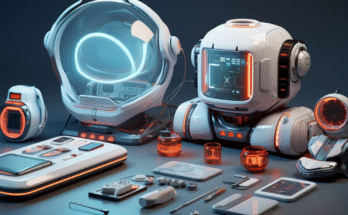The Future of Phones: Reimagining how to connect, work and live
Mobile phone has developed to be a pocket-sized home of communications, entertainment, productivity, and self-expression out of being a luxury device solely used to communicate via voice. It has changed our lives and even our social lives and global business that occurred in the past 20 years or so. However, there are more incredible changes to the future of phones as technology is racing ahead at blistering pace.
However, in the next few years, the phones can be expected to take quite a leap in the way they are used in the present comparison with rectangular bodies of glass and metal. They will be more immersive, smart, integrated, and personalized and digital and physical worlds will merge. This journal article discusses the most important trends and innovations that look forward to a future of phones and their implications to the individuals, businesses and the whole society.
1. Hardware evolution: Hardware beyond the glass rectangle
And that road has been down a predictable direction in smartphone design that has been pushing towards larger screens, less bezel to screen ratio, and overall appearance that is sleek. These frontiers will be expanded in many directions in the next era:
a. Foldable Displays/Rollable Displays
Flexible displays phones are already available in the market, but they will be lighter, tougher, and cheaper in the future. Rollable phones would have the potential to increase the length of the screen dynamically as required- perfect in gaming, multitasking or video watching- or roll up to fit in your pocket.
b. See Through and Transparent Screens
Further research and development into OLED and microLED may yield transparent screens, which, in turn, may enable phones to be used as AR (augmented reality) devices without headsets. First, think of how you might hold your phone to your eyes in order to see live translations written over foreign street signs.
c. Module Designs
Although modular phones are not an original idea, it could take a second life due to better engineering and sustainability requirements. Future devices could enable customers to very easily replace the camera, battery or processor, or other parts, resulting in less e-waste and also increasing the life of the product.
d. Advanced Materials
Phones could be longer-lasting, quicker to charge, and more planet-friendly through self-healing elements, graphene-based batteries and ultra-light alloys. Flexible, scratch-resistant, surfaces may replace the Gorilla Glass and repair small dents automatically.
2. Battery/Power Breakthroughs
Battery life is one of the worst frustrating limitations of the current smartphones. This may look very different in the future:
Graphene Batteries- Will take 15 minutes or less to go to 0 percent to full 100 percent and have a longer life span.
Solar and Ambient Charging- Gadgets that can extract small levels of energy in the form of light, body heat or even motion, minimizing the need to use the typical forms of charging.
Distance Charging Across the Air – The over-the-air charging technology would allow the reference of the power of the device to a distance of few meters of its transmitter and the wired charging would be thing of the past.
Smart power management using AI Use pattern recognition to efficiently use the power generated by phones.
3. Future Camera: Photography to Perception
Phone cameras will not only record memories, but they will see and interpret the world in the future:
Holographic Capture: Instead of listing short photos and vids, phones will record Holo-dimensional 3D holograms that the viewer can see in any directions.
Multi-Spectral Imaging – Cameras will be able to see what humans cannot, sensor the heat, view at night, or even what the camera can tell of a material to aid industrial or safety needs.
Enhanced Creativity Using AI- Cinematic-grade video will be possible in real time, with flawless lighting, and ability to change the background in real time, no post-editing required.
Microscopic Zoom Lenses with magnification strength encouraged to use them as portable microscopes in science, medical, and education.
4. Connectivity: On/Everywhere
Ultra-fast, ultra-reliable connectivity is the right environment in which the future phones will flourish:
6G Networks- The next generation type of network expected in the early 2030s, and 6G should be 100 times the speed of 5G and enable latency-free processes and applications, such as remote surgery, full immersion augmented reality.
Satellite integration – phones will be integrated with satellite communication to cover rural and areas affected by disasters easily.
Mesh Networking – Connecting the devices will not be based on based cell towers only, as mesh networking will improve resilience during emergencies.
Quantum Communication- Quantum networking is now an experimental technology that may allow strong encryption that cannot be broken and allows transporting data over vast distances in real time.
5. Artificial Intelligence: Phones That Do Know You
The current use of AI in smartphones can be regarded as already sizable, but, in the future, it will have even closer, more personalized integration:
Proactive Help – Phones will be able to predict things, such as letting you know that it is time to schedule a ride to work, or telling you what to wear according to what the weather is or what it is in the calendar.
Real-Time Language Translation- Communication between engaged parties in different languages will not be a problem, because of instant voice and text conversion.
Personal Health Companion – At the next technological level, your phone will scan vital signs, notice an early onset of an illness and propose precautionary actions.
Learning What You Like– The interface will be molded and shaped by AI, rearranging things, prioritizing notifications, and altering user and machine interactions based on your tendencies and how you feel.
6. AR-VR Combination
Phones are going to be more combined with AR and VR tech:
Two glasses, connected to your phone, could provide a heads-up display of navigation, messages, etc. Instead of peering down at a screen.
Holographic Displays Holograms are a rich source of possibilities with phones projecting images by way of interactive holograms into the air, allowing people to use them without touching them.
3D Communication- Video calling is set to become a holographic chat that would enable long distant communication to feel like a personal communication.
Mixed Reality Workspaces –Virtual desktops, meeting rooms and collaborative design spaces will be powered by phones used by professionals.
7. Environment Friendly and Sustainable Innovation
The phones environmental impact is beginning to draw more attention and going forward they will directly greet the issue:
Recyclable and Biodegradable Parts – Parts will also be increasingly composed of recycled – and recyclable – metals, plastics and plant-based materials.
Repairability- Right-to-repair regulation and modular products will promote post-use of products.
Low-Carbon Manufacturing -The companies will change to renewable energy and friendly environment production.
E-Waste Buyback Programs- this is where the manufacturers will encourage the use of old machines by offering incentive to users to send the old products back to the manufacturers so that they can re-use them or recycle them.
8. Security and Privacy in The Hyperconnected World
It will be very important to keep personal information safe as phones get more potent and integrated:
Biometric Developments-With fingerprints and facial recognition still in vogue, there exists the possibility of using heartbeat pattern, vein chart or brainwave log-in on phones.
On-Device AI Processing- Sensitive data will be kept and done locally, reducing cloud based risks.
Decentralized Identity Management where the user could maintain and hold their identity credentials conveniently and safely without interfering with central databases.
Advanced encryption Quantum-safe encryption techniques will protect information during sensitive communications and transactions.
9. Life with a Universal Remote- the Phone
Your phone may be the one day the hub of everything digital and on-ground in your life:
Lighting Control- Dynamic control of lights, appliances, security and energy systems with a single interface.
Digital Wallets Phones will work as a substitute not only to credit cards, but also to IDs, passports, and keys.
Vehicle Integration – your mobile could be used as the vehicle key, map, audio and video, and vehicle diagnostic.
Personal Robotics- Control personal drones, cleaning robots or delivery through your phone.
10. Challenges Ahead
Although the future of phones is promising, a number of issues will have to be resolved:
Digital Overload As phones continue to get immersive it will become important to use screens and be able to balance the time spends on the screen and interacting with others.
Security Risks- Greater the features greater the vulnerability; extensive cybersecurity will be absolutely necessary.
Expenses and Accessibility The new technology should be affordable and inclusive because it should not be used to create a knowledge hitch.
Ethical AI Use The need to assure the society that the AI-powered phones make a just, non-discriminatory, and transparent decision will be a major task.
Environmental Impact: In spite of the greener technologies, the sustainability question arises when viewed regionally in terms of large-scale production and consumption.
11. What to anticipate in the Next Decade
The concept of a phone in 2035 could be totally different than it is right now. We may not need to carry along a separate device anymore, but will connect with a distributed ecosystem of wearable, implantable, and ambient computing systems in a manner where the phone becomes the smart hub.
The two Form Factors Foldables and wearables will exist together with a significant number of the users to use the AR glasses or smart contact lenses.
Interfaces- Voice, gesture, and brain-computer interfaces will eliminate the use of touchscreen.
Usefulness- The phone will be a physical and digital combination, always at hand with health, work and play.
The takeaway: It is not Just a Phone
It is not simply the hardware that makes phones of the future so exciting, it is the reappropriation of our interaction with technology and vitalization of our interactions with one another. Artificial intelligence, connectivity, sustainability, and immersive experiences are all coming together. Phone will turn into smart companions that will be almost aware of needs, increase the inherent capabilities of humans and soon bridge distances like never before.
Though these innovations show the potential of the greatest benefits, they require consideration and design, moral protection, and universal access. The best future phones are not just going to be more potent, they are going to be more personal, more mindful of the autonomy of the person using them and will become more deeply embedded into our everyday activities.
And as far as history is concerned, chances are that the gadgets we know as phones today will be as outdated as rotary dials or mobile 80s size will pretty soon feel like. What the next generation of phones could look like is just one question-the bigger question is how these phones could change the world in which we live.




